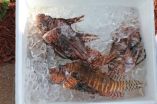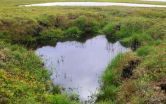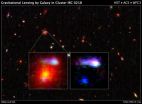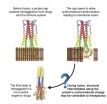(Press-News.org) AMHERST, Mass. – A first-of-its-kind study of bigeye tuna movements in the northwestern Atlantic Ocean led by Molly Lutcavage, director of the Large Pelagics Research Center at the University of Massachusetts Amherst, found among other things that these fish cover a wide geographical range with pronounced north-south movements from Georges Bank to the Brazilian shelf, and they favor a high-use area off Cape Hatteras southwest of Bermuda for foraging.
This NOAA-funded research, which used a new approach to study one of the most important commercial tuna species in the Atlantic, provides the longest available fishery-independent record of bigeye tuna movements to date. Data should help researchers to further characterize habitat use and assess the need for more monitoring in high-catch areas.
Results appear this week in an early online edition of the Canadian Journal of Fisheries and Aquatic Science.
Fisheries oceanographer Lutcavage says, "Although Atlantic bigeye tuna are delivering high prices to the U.S. commercial fleet and are highly sought by recreational fishermen and fishing tournaments, there's been a surprising lack of scientific research on this species. And in contrast to the Pacific, where tuna fisheries programs have deployed over 400,000 tags over 25 years, the Atlantic lacks the fisheries infrastructure that would increase the odds of recovering tags. We have to rely on popup satellite tags that are fishery independent to make sure we get information back from the tuna."
Two earlier electronic tagging studies by others yielded relatively short tracking data, 113 days or fewer, and did not allow for seasonal analysis of movement or exploration of an alternate stock composition hypotheses, Lutcavage and colleagues note. Bigeye are currently managed as a single Atlantic stock, she explains, and the greater resolution of habitat use and migratory behavior revealed in this study are important first steps towards determining whether or not a more complex management approach may be warranted.
Working with pelagic longline vessel captains Scott Drabinowicz and John Caldwell of the FV Eagle Eye II out of Fairhaven, Mass., Lutcavage, with LPRC colleagues Tim Lam and doctoral candidate Ben Galuardi, deployed 21 pop-up satellite archival tags (PSAT) on adult bigeye tuna between 2008 and 2010 in the northwest Atlantic. The sea captains fit tags on fish in good condition and return them to the sea. The PSATs were programmed to record relative light level, temperature and pressure (depth) every two minutes for eight or 12 months.
Lutcavage, Lam and Galuardi were able to collect full-resolution time series data from a total of nine tags, providing data ranging from one to 292 days. The team also downloaded remote sensing and climatological information from the NOAA to characterize possible associations between bigeye tuna movement and behavior and environmental factors.
Among variables they analyzed were the bigeyes' use of the deep scattering layer for foraging. That is an ocean layer of marine life that rises and falls in relation to diurnal vertical migration. The researchers also looked at lunar influences on swimming depth, horizontal movements, plus vertical activity and factors influencing it such as temperature.
Lam explains, "Bigeye tuna dive deeply, like clockwork, at dusk and dawn, making it hard to use light-based geolocation methods to estimate their daily locations. Here, we showcase a new positioning technique to get around the problem of low light levels at depth by using temperature and the bigeyes' spatial ecology and movements in the western Atlantic. But there's much more to learn."
The authors hope their results will inform the International Commission for the Conservation of Atlantic Tuna's upcoming tagging effort and assist ICCAT scientists as they plan new research to better understand the population.
Alain Fonteneau, an emeritus scientist at France's Institut de Recherches pour le Développement and a recognized expert member of scientific panels that manage regional tuna fisheries worldwide, called this work "fantastic." He says, "Although we don't see major unexpected surprises in these results, as we often see with Atlantic bluefin tuna results, this paper is the first one in the scientific literature to provide very new and very interesting results on bigeye vertical and geographical movements in the western Atlantic," he points out.
Fonteneau adds, "Although these real observations are based on a small number of PSAT tags, they are much more comprehensive than the traditional catch-and-effort fishery data, at one time the only type available to ICCAT tuna scientists. It would clearly be of major scientific interest to develop this type of work at the scale of the entire Atlantic Ocean."
INFORMATION:
Study of bigeye tuna in Northwest Atlantic uses new tracking methods
A first-of-its-kind study of bigeye tuna in the northwestern Atlantic found that they cover a wide geographical range with pronounced north-south shifts from Georges Bank to the Brazilian shelf, and favor a high-use foraging area off Cape Hatteras
2014-07-31
ELSE PRESS RELEASES FROM THIS DATE:
Unintended consequences: More high school math, science linked to more dropouts
2014-07-31
As U.S. high schools beef up math and science requirements for graduation, researchers at Washington University in St. Louis have found that more rigorous academics drive some students to drop out.
The research team reported in the June/July issue of the journal Educational Researcher that policies increasing the number of required high school math and science courses are linked to higher dropout rates.
"There's been a movement to make education in the United States compare more favorably to education in the rest of the world, and part of that has involved increasing ...
Is it really a concussion? Symptoms overlap with neck injuries so diagnosis is tough call
2014-07-31
BUFFALO, N.Y. – Athletes and others reporting cognitive difficulties after a head injury are usually diagnosed as having had a concussion. But is it really a concussion? A new study published by University at Buffalo medical faculty finds that many of the same symptoms are common to concussions and to injuries to the neck and/or balance system, known collectively as cervical/vestibular injuries.
The research was based on responses about symptoms from 128 patients – some of whom were professional athletes – who were being treated at UB's Concussion Management Clinic in ...
Invasive lionfish likely safe to eat after all
2014-07-31
Scientists have learned that recent fears of invasive lionfish causing fish poisoning may be unfounded. If so, current efforts to control lionfish by fishing derbies and targeted fisheries may remain the best way to control the invasion. And there's a simple way to know for sure whether a lionfish is toxic: test it after it's been cooked.
Pacific lionfish were first reported off the coast of Florida in the 1980s, and have been gaining swiftly in number ever since. They're now found in marine habitats throughout the tropical and subtropical Western Atlantic, Caribbean ...
Certain Arctic lakes store more greenhouse gases than they release
2014-07-31
New research, supported by the National Science Foundation (NSF), counters a widely-held scientific view that thawing permafrost uniformly accelerates atmospheric warming, indicating instead that certain Arctic lakes store more greenhouse gases than they emit into the atmosphere.
The study, published this week in the journal Nature, focuses on thermokarst lakes, which occur as permafrost thaws and creates surface depressions that fill with melted fresh water, converting what was previously frozen land into lakes.
The research suggests that Arctic thermokarst lakes ...
NASA's Fermi space telescope reveals new source of gamma rays
2014-07-31
Observations by NASA's Fermi Gamma-ray Space Telescope of several stellar eruptions, called novae, firmly establish these relatively common outbursts almost always produce gamma rays, the most energetic form of light.
"There's a saying that one is a fluke, two is a coincidence, and three is a class, and we're now at four novae and counting with Fermi," said Teddy Cheung, an astrophysicist at the Naval Research Laboratory in Washington, and the lead author of a paper reporting the findings in the Aug. 1 edition of the journal Science.
A nova is a sudden, short-lived brightening ...
Study finds physical link to strange electronic behavior
2014-07-31
HOUSTON -- (July 31, 2014) -- Scientists have new clues this week about one of the baffling electronic properties of the iron-based high-temperature superconductor barium iron nickel arsenide. A Rice University-led team of U.S., German and Chinese physicists has published the first evidence, based on sophisticated neutron measurements, of a link between magnetic properties and the material's tendency, at sufficiently low temperatures, to become a better conductor of electricity in some directions than in others.
The odd behavior, which has been documented in a number ...
Hubble shows farthest lensing galaxy yields clues to early universe
2014-07-31
Astronomers using NASA's Hubble Space Telescope have unexpectedly discovered the most distant galaxy that acts as a cosmic magnifying glass. Seen here as it looked 9.6 billion years ago, this monster elliptical galaxy breaks the previous record-holder by 200 million years.
These "lensing" galaxies are so massive that their gravity bends, magnifies, and distorts light from objects behind it, a phenomenon called gravitational lensing. Finding one in such a small area of the sky is so rare that you would normally have to survey a region hundreds of times larger to find just ...
Researchers uncover clues to flu's mechanisms
2014-07-31
HOUSTON – (July 31, 2014) – A flu virus acts like a Trojan horse as it attacks and infects host cells. Scientists at Rice University and Baylor College of Medicine have acquired a clearer view of the well-hidden mechanism involved.
Their computer simulations may lead to new strategies to stop influenza, perhaps even a one-size-fits-all vaccine.
The discovery detailed this week in the Proceedings of the National Academy of Science shows the path taken by hemagglutinin, a glycoprotein that rides the surface of the influenza virus, as it releases fusion peptides to invade ...
UF study advances 'DNA revolution,' tells butterflies' evolutionary history
2014-07-31
GAINESVILLE, Fla. --- By tracing nearly 3,000 genes to the earliest common ancestor of butterflies and moths, University of Florida scientists have created an extensive "Tree of Lepidoptera" in the first study to use large-scale, next-generation DNA sequencing.
Among the study's more surprising findings: Butterflies are more closely related to small moths than to large ones, which completely changes scientists' understanding of how butterflies evolved. The study also found that some insects once classified as moths are actually butterflies, increasing the number of butterfly ...
NYU CDUHR researchers look at prescription opioid abuse among young adults in NYC
2014-07-31
The prevalence of heroin use has been rising steadily in the U.S in recent years. According to the National Survey on Drug Use and Health, the number of individuals reporting past year heroin use almost doubled between 2007 (373,000) and 2012 (669,000). Emerging evidence suggests the increase may be linked to prescription opioid (PO) users who transition from oral and/or intranasal PO use to heroin use, with POs providing the entryway to regular opioid use, and ultimately, heroin injection. This drug-use trajectory appears to have become increasingly common over the past ...
LAST 30 PRESS RELEASES:
Stardust study resets how life’s atoms spread through space
Practical education: Clinical scenario-based program development
The impact of family dynamics on eating behaviour – how going home for Christmas can change how you eat
Tracing the quick synthesis of an industrially important catalyst
New software sheds light on cancer’s hidden genetic networks
UT Health San Antonio awarded $3 million in CPRIT grants to bolster cancer research and prevention efforts in South Texas
Third symposium spotlights global challenge of new contaminants in China’s fight against pollution
From straw to soil harmony: International team reveals how biochar supercharges carbon-smart farming
Myeloma: How AI is redrawing the map of cancer care
Manhattan E. Charurat, Ph.D., MHS invested as the Homer and Martha Gudelsky Distinguished Professor in Medicine at the University of Maryland School of Medicine
Insilico Medicine’s Pharma.AI Q4 Winter Launch Recap: Revolutionizing drug discovery with cutting-edge AI innovations, accelerating the path to pharmaceutical superintelligence
Nanoplastics have diet-dependent impacts on digestive system health
Brain neuron death occurs throughout life and increases with age, a natural human protein drug may halt neuron death in Alzheimer’s disease
SPIE and CLP announce the recipients of the 2025 Advanced Photonics Young Innovator Award
Lessons from the Caldor Fire’s Christmas Valley ‘Miracle’
Ant societies rose by trading individual protection for collective power
Research reveals how ancient viral DNA shapes early embryonic development
A molecular gatekeeper that controls protein synthesis
New ‘cloaking device’ concept to shield sensitive tech from magnetic fields
Researchers show impact of mountain building and climate change on alpine biodiversity
Study models the transition from Neanderthals to modern humans in Europe
University of Phoenix College of Doctoral Studies releases white paper on AI-driven skilling to reduce burnout and restore worker autonomy
AIs fail at the game of visual “telephone”
The levers for a sustainable food system
Potential changes in US homelessness by ending federal support for housing first programs
Vulnerability of large language models to prompt injection when providing medical advice
Researchers develop new system for high-energy-density, long-life, multi-electron transfer bromine-based flow batteries
Ending federal support for housing first programs could increase U.S. homelessness by 5% in one year, new JAMA study finds
New research uncovers molecular ‘safety switch’ shielding cancers from immune attack
Bacteria resisting viral infection can still sink carbon to ocean floor
[Press-News.org] Study of bigeye tuna in Northwest Atlantic uses new tracking methodsA first-of-its-kind study of bigeye tuna in the northwestern Atlantic found that they cover a wide geographical range with pronounced north-south shifts from Georges Bank to the Brazilian shelf, and favor a high-use foraging area off Cape Hatteras









